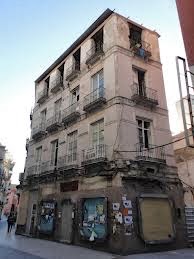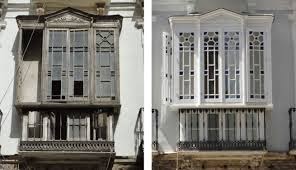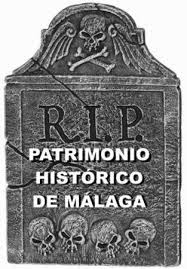The city centre is full of unique
buildings abandoned and dilapidated, with its decay we are losing the
heritage that belongs to this city
 Watchful
eyes bear witness to
a Málaga that
lies dying
in its own ruins. Broken windows, boarded up
doors, tiles and balconies detached. A
distant splendour is fading year after year, a
result of
the owners negligence and an apathy of
governing institutions.
Watchful
eyes bear witness to
a Málaga that
lies dying
in its own ruins. Broken windows, boarded up
doors, tiles and balconies detached. A
distant splendour is fading year after year, a
result of
the owners negligence and an apathy of
governing institutions.
In the historic centre of the city, dozens of unique buildings are abandoned and dilapidated. The Planning Department has forced owners to repair the outside of the building to pass the Technical Building Inspection (ITE ) . However, there are many others which are slowly crumbling.
 Antonio
Vargas, Dean of the
College of Architects and professor of
'Escuela de Arquitectura de la
Universidad de Málaga' states
“you only have to make a brief tour through
the streets of Madre de
Dios, Dos Aceras,
Alamos and Carreteria to check numerous examples of this lack of
action, these properties are privately owned
but also belong to the community”.
Antonio
Vargas, Dean of the
College of Architects and professor of
'Escuela de Arquitectura de la
Universidad de Málaga' states
“you only have to make a brief tour through
the streets of Madre de
Dios, Dos Aceras,
Alamos and Carreteria to check numerous examples of this lack of
action, these properties are privately owned
but also belong to the community”.
“We talk about heritage but we should look for a more intense surveillance system before reaching total ruination, more frequent inspections, regulations with greater demands and controls not only on the livability but to also maintain the architectural value of these buildings" added Antonio Vargas. Citing a specific example, El Palacete Barroco de Trinidad Grund. the baroque palace.

Amongst
La Calle
Tejón, Calle Rodríguez
and La Plaza
del Teatro, there has for
years been rising
scaffolding skeletons
supporting buildings
with nothing more that vegetation
inside. "These are
more obvious cases,"
says Vargas and suggests that developers are purposefully leaving
the properties to come
crashing down to make
way for redevelopment projects.
 For
the architect and university professor, in
certain cases "compulsory purchase would most suit the common good ".
However, the dean of the College of Architects believes that "
the authorities are very wary and provide guarantees to the
individual rather than the collective, denying
the right of citizens to enjoy their heritage." he
goes on to stress that “In all this lies the
culture of high prices and the want
to get the maximum return”.
For
the architect and university professor, in
certain cases "compulsory purchase would most suit the common good ".
However, the dean of the College of Architects believes that "
the authorities are very wary and provide guarantees to the
individual rather than the collective, denying
the right of citizens to enjoy their heritage." he
goes on to stress that “In all this lies the
culture of high prices and the want
to get the maximum return”.
 A
key factor in the abandonment of these properties is the ownership
structure. Sometimes the owners are elderly or their heirs don't
want act responsibly. In Calle
Madre de Dios, No10,
a unique building does not look to have passed the statutory
inspection, Another,
had the openings on the
ground floor windows boarded up but has been
broken into and
stands open to
slowly corrode.
A
key factor in the abandonment of these properties is the ownership
structure. Sometimes the owners are elderly or their heirs don't
want act responsibly. In Calle
Madre de Dios, No10,
a unique building does not look to have passed the statutory
inspection, Another,
had the openings on the
ground floor windows boarded up but has been
broken into and
stands open to
slowly corrode.
In Dos Aceras and Alamos façades are propped to hide the empty interiors. In Carreteria No 31 moldings have fallen away and police had to act to prevent injury due to falling cornices.
The Professor continues " Public space is not only the soil of the street, the cobblestones beneath our feet , it is also are the buildings that line those streets ,"
another example of neglect in Pasaje de Chinitas, floors that form the fabric of buildings has been torn off and gutters are so unstable that a metal plate protects pedestrians from falling material .
In this proud city the Malagueños are now used to walking through its dying streets and so to must the visitors who pay to come and see this Malaga, this 'paradise'
quotes from interview by
C Ristina Fernández málaga Hoy |
C Ristina Fernández málaga Hoy |



No comments:
Post a Comment